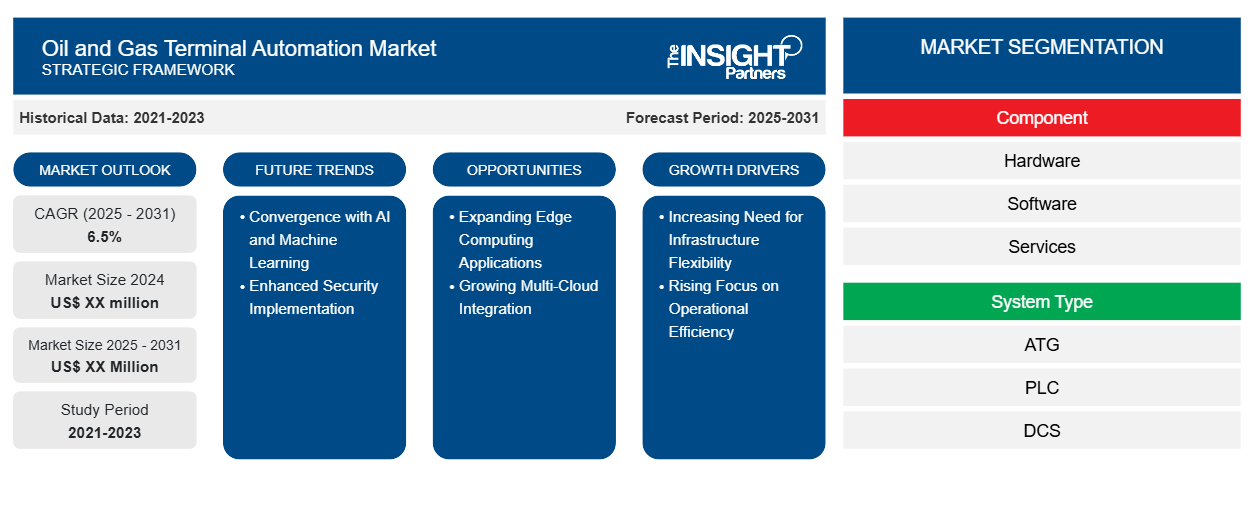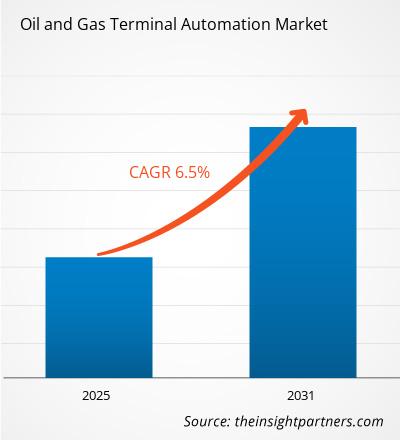The Oil and Gas Terminal Automation Market is expected to register a CAGR of 6.5% from 2025 to 2031, with a market size expanding from US$ XX million in 2024 to US$ XX Million by 2031.
The report is segmented by Component (Hardware, Software, Services), System Type (ATG, PLC, DCS, HMI, SCADA, Blending Controllers, Others), Operation (Terminal and Inventory Management, Business System Integration, Reporting, Transaction Management, Others). The global analysis is further broken-down at regional level and major countries. The Report Offers the Value in USD for the above analysis and segments.
Purpose of the Report
The report Oil and Gas Terminal Automation Market by The Insight Partners aims to describe the present landscape and future growth, top driving factors, challenges, and opportunities. This will provide insights to various business stakeholders, such as:
- Technology Providers/Manufacturers: To understand the evolving market dynamics and know the potential growth opportunities, enabling them to make informed strategic decisions.
- Investors: To conduct a comprehensive trend analysis regarding the market growth rate, market financial projections, and opportunities that exist across the value chain.
- Regulatory bodies: To regulate policies and police activities in the market with the aim of minimizing abuse, preserving investor trust and confidence, and upholding the integrity and stability of the market.
Oil and Gas Terminal Automation Market Segmentation
Component
- Hardware
- Software
- Services
System Type
- ATG
- PLC
- DCS
- HMI
- SCADA
- Blending Controllers
Operation
- Terminal and Inventory Management
- Business System Integration
- Reporting
- Transaction Management
Geography
- North America
- Europe
- Asia Pacific
- Middle East and Africa
- South and Central America
You will get customization on any report - free of charge - including parts of this report, or country-level analysis, Excel Data pack, as well as avail great offers and discounts for start-ups & universities
Oil and Gas Terminal Automation Market: Strategic Insights

- Get Top Key Market Trends of this report.This FREE sample will include data analysis, ranging from market trends to estimates and forecasts.
Oil and Gas Terminal Automation Market Growth Drivers
- Increasing Need for Infrastructure Flexibility: The growing demand for adaptable and scalable IT infrastructure is driving SDx adoption across industries. Traditional hardware-centric architectures are proving too rigid for rapidly evolving business needs. Software-defined solutions enable organizations to dynamically adjust their infrastructure through programmatic control, reducing dependency on physical hardware changes. This flexibility allows quick response to changing workload demands, faster deployment of new services, and more efficient resource utilization. The ability to reconfigure network, storage, and compute resources through software commands has become crucial for organizations undergoing digital transformation, particularly in cloud environments where agility and scalability are paramount.
- Rising Focus on Operational Efficiency: Organizations' intensifying drive to reduce operational costs while improving service delivery is propelling SDx market growth. Manual configuration and management of infrastructure components are time-consuming and error-prone. Software-defined approaches automate routine tasks, streamline operations, and reduce human intervention in infrastructure management. This automation significantly reduces operational expenses while improving consistency and reliability. The centralized control and management capabilities of SDx solutions enable organizations to implement standardized policies, ensure compliance, and optimize resource allocation across their entire infrastructure, leading to substantial efficiency gains and cost savings.
Oil and Gas Terminal Automation Market Future Trends
- Convergence with AI and Machine Learning: The integration of artificial intelligence and machine learning capabilities into SDx solutions is emerging as a significant trend. These technologies enable predictive infrastructure optimization, automated problem resolution, and intelligent resource allocation. AI-powered SDx systems can analyze patterns in resource usage, predict potential issues, and automatically adjust configurations to optimize performance. This trend is particularly evident in large-scale deployments where manual monitoring and optimization become impractical. The combination of AI with software-defined infrastructure is creating self-optimizing systems that can adapt to changing conditions without human intervention.
- Enhanced Security Implementation: The evolution of security features within SDx architectures is becoming a defining trend as organizations prioritize cyber defense. Software-defined security enables dynamic policy enforcement, microsegmentation, and automated threat response across the infrastructure. This trend reflects the need for security measures that can adapt as quickly as threats evolve. Organizations are implementing comprehensive security frameworks that leverage the programmability of SDx to create zero-trust environments, enforce compliance requirements, and protect against sophisticated cyber threats through automated detection and response mechanisms.
Oil and Gas Terminal Automation Market Opportunities
- Expanding Edge Computing Applications: The rapid growth of edge computing presents significant opportunities for SDx implementation. As organizations deploy more computing resources at the network edge, software-defined infrastructure becomes crucial for managing distributed environments effectively. SDx enables consistent policy enforcement, resource optimization, and security across edge locations while maintaining centralized control. This opportunity encompasses various applications, from IoT device management to content delivery networks, where the ability to programmatically control infrastructure at the edge provides substantial advantages in performance and efficiency.
- Growing Multi-Cloud Integration: The increasing adoption of multi-cloud strategies creates substantial opportunities for SDx solutions. Organizations need tools to manage and orchestrate resources across multiple cloud providers and on-premises infrastructure seamlessly. Software-defined approaches enable consistent management, security policies, and service delivery across diverse cloud environments. This opportunity includes developing tools for cloud-agnostic resource management, automated workload migration, and unified policy enforcement. The complexity of managing hybrid and multi-cloud environments drives demand for sophisticated SDx solutions that can abstract and simplify these operations.
Oil and Gas Terminal Automation Market Regional Insights
The regional trends and factors influencing the Oil and Gas Terminal Automation Market throughout the forecast period have been thoroughly explained by the analysts at The Insight Partners. This section also discusses Oil and Gas Terminal Automation Market segments and geography across North America, Europe, Asia Pacific, Middle East and Africa, and South and Central America.
Oil and Gas Terminal Automation Market Report Scope
| Report Attribute | Details |
|---|---|
| Market size in 2024 | US$ XX million |
| Market Size by 2031 | US$ XX Million |
| Global CAGR (2025 - 2031) | 6.5% |
| Historical Data | 2021-2023 |
| Forecast period | 2025-2031 |
| Segments Covered |
By Component
|
| Regions and Countries Covered | North America
|
| Market leaders and key company profiles |
|
Oil and Gas Terminal Automation Market Players Density: Understanding Its Impact on Business Dynamics
The Oil and Gas Terminal Automation Market is growing rapidly, driven by increasing end-user demand due to factors such as evolving consumer preferences, technological advancements, and greater awareness of the product's benefits. As demand rises, businesses are expanding their offerings, innovating to meet consumer needs, and capitalizing on emerging trends, which further fuels market growth.

- Get the Oil and Gas Terminal Automation Market top key players overview
Key Selling Points
- Comprehensive Coverage: The report comprehensively covers the analysis of products, services, types, and end users of the Oil and Gas Terminal Automation Market, providing a holistic landscape.
- Expert Analysis: The report is compiled based on the in-depth understanding of industry experts and analysts.
- Up-to-date Information: The report assures business relevance due to its coverage of recent information and data trends.
- Customization Options: This report can be customized to cater to specific client requirements and suit the business strategies aptly.
The research report on the Oil and Gas Terminal Automation Market can, therefore, help spearhead the trail of decoding and understanding the industry scenario and growth prospects. Although there can be a few valid concerns, the overall benefits of this report tend to outweigh the disadvantages.
Frequently Asked Questions
What are the deliverable formats of the oil and gas terminal automation market report?
What are the options available for the customization of this report?
What are the future trends of the oil and gas terminal automation market?
1. Cloud Computing and Big Data Analytics
2. Robotic Process Automation (RPA)
3. Energy Efficiency and Sustainability Focus
What are the driving factors impacting the oil and gas terminal automation market?
1. Operational Efficiency and Cost Reduction
2. Safety and Regulatory Compliance
3. Integration with Supply Chain Management
What is the expected CAGR of the Oil and Gas Terminal Automation Market Size and Forecasts (2021 - 2031), Global and Regional Share, Trends, and Growth Opportunity Analysis Report Coverage: By Component (Hardware, Software, Services), System Type (ATG, PLC, DCS, HMI, SCADA, Blending Controllers, Others), Operation (Terminal and Inventory Management, Business System Integration, Reporting, Transaction Management, Others ), and Geography (North America, Europe, Asia Pacific, Middle East & Africa, South & Central America)?
- Historical Analysis (2 Years), Base Year, Forecast (7 Years) with CAGR
- PEST and SWOT Analysis
- Market Size Value / Volume - Global, Regional, Country
- Industry and Competitive Landscape
- Excel Dataset
Recent Reports
Related Reports
Testimonials
Reason to Buy
- Informed Decision-Making
- Understanding Market Dynamics
- Competitive Analysis
- Identifying Emerging Markets
- Customer Insights
- Market Forecasts
- Risk Mitigation
- Boosting Operational Efficiency
- Strategic Planning
- Investment Justification
- Tracking Industry Innovations
- Aligning with Regulatory Trends





















 Get Free Sample For
Get Free Sample For